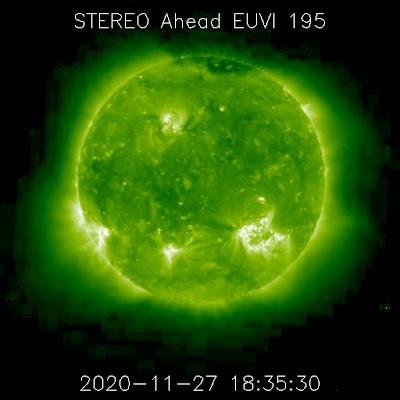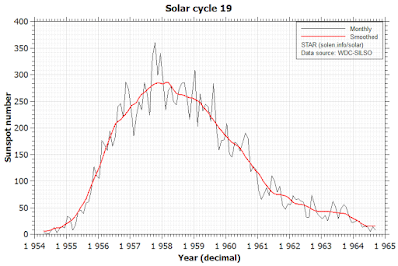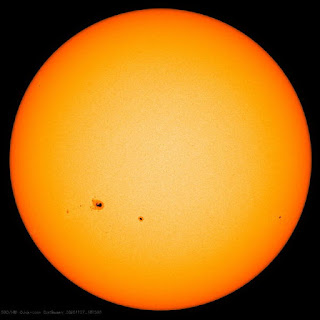 Strongest X-Ray Solar Flare in New Cycle 25! A Class M4.4 Flare on 29 Nov 2020
Strongest X-Ray Solar Flare in New Cycle 25! A Class M4.4 Flare on 29 Nov 2020
Visit, subscribe: NW7US Radio Communications and Propagation YouTube Channel
 Choosing A First Handheld Radio
Choosing A First Handheld Radio
 Once again, I was asked by a new ham “which handheld transceiver should I get?” This is a frequent and valid question that comes up. Often the question gets framed as “Baofeng or something better?” I say “something better.” I am not writing to bash Baofeng radios or the people that use them. The radios are an incredible value on the low end of the market…amazing what they can do for $30 or so. Besides, I own several of them. I just think that if you have a few more $$ to spend, you can get a much better radio. What’s wrong with these low-end Chinese radios? Out of spec harmonics on transmit and poor adjacent channel rejection on receive.
Once again, I was asked by a new ham “which handheld transceiver should I get?” This is a frequent and valid question that comes up. Often the question gets framed as “Baofeng or something better?” I say “something better.” I am not writing to bash Baofeng radios or the people that use them. The radios are an incredible value on the low end of the market…amazing what they can do for $30 or so. Besides, I own several of them. I just think that if you have a few more $$ to spend, you can get a much better radio. What’s wrong with these low-end Chinese radios? Out of spec harmonics on transmit and poor adjacent channel rejection on receive.
Digital? Probably Not
The other question that usually surfaces is “should I get a digital radio?” Here “digital radio” means D-STAR, Yaesu Fusion or DMR. My answer to that is “No,” unless you have a specific reason for going digital. Adding digital to a radio results in two things: 1) a higher price and 2) a more complex radio. Actually, the price difference may not be that significant, especially for a DMR radio. However, the complexity factor is always there.
What is a specific reason for going digital? You already know that there are digital repeaters in your area that you want to use, you have ham radio friends already using digital or you are technically-oriented and have researched the topic to know that it is something you want to try. If one of these things is true, then go for it.
Oh, you do need to know which digital format to get. No radio does them all and the industry is fragmented between D-STAR, Fusion and DMR. I find this very disappointing but life is sometimes like that.
Narrowing It Down
So narrowing the topic down, we are looking for an affordable (under $100) dual-band handheld that is not a cheap Chinese radio (Baofeng, etc.) and is not a fancy digital radio. My opinion is the quality ham radio manufacturers are pretty much Alinco, Icom, Kenwood, and Yaesu. The price points on basic handheld transceivers keep changing, so be sure to check the date on this post and do a little price shopping.
The Alinco DJ-VX50 is about $100, so not too expensive, but I am not seeing any eham.net product reviews on it. Also, it seems to be out of stock at several vendors, so I am not sure of its production status. Icom and Kenwood have exited the low-end handheld market, so nothing to consider there. This leaves Yaesu as the only “brand name” player in this space. I have been recommending the Yaesu FT-4XR as a good alternative: see What About the Yaesu FT-4XR? at about $80. I recently noticed that the Yaesu FT-65R has come down in price to about $85. With this price difference, it probably makes sense to go with the FT-65R. (I really wonder about Yaesu’s product line strategy at this point. Why are there two similar radios priced so close together?)
Here is a quick comparison of the two radios: Yaesu FT-4XR vs FT-65R, which is right for you? Conclusion: FT-65R is probably better for most people. Also, check out the HamRadioSchool.com article: Yaesu FT-65R Product Review. The eham.net product reviews are generally positive on the FT-65R, but there are a few negative themes that surface. Some people are reporting radio failures that may indicate a manufacturing issue with the product. (It is made in China.)
The Good Old FT-60
The other theme that surfaces is that the FT-65R is not a complete replacement for the venerable FT-60R. Joyce/K0JJW and I have a couple of FT-60Rs that we really like and frequently use. Yaesu still sells this older model because it is so popular and, frankly, it is a really solid radio. The HamRadioSchool.com review of the FT-65R mentions several things that people tend to like on the FT-60R that were left out of the FT-65R (e.g., dedicated VFO and Squelch knobs.) The biggest complaint I hear about the FT-60R is that it has an old-school NiMH battery (the FT-65R has lithium-ion).
My conclusion is to recommend the FT-65R to newcomers to the hobby. At ~$85, it fits most people’s budgets. There is some risk that you will outgrow it down the road and want a more capable handheld for digital or APRS or whatnot. In that scenario, the FT-65R will still be a good second/backup radio. (Ya gotta have more than one, right?)
That’s my opinion. What y’all think?
73 Bob K0NR
The post Choosing A First Handheld Radio appeared first on The KØNR Radio Site.
Bob Witte, KØNR, is a regular contributor to AmateurRadio.com and writes from Colorado, USA. Contact him at [email protected].
 CQ WW CW 2020 contest is on the books!
CQ WW CW 2020 contest is on the books!
This past weekend was the CQ WW CW contest which if I can I always partake in. This year I made it a point to set aside the time to indulge.....well I'm retired now so it's really not all that hard to set the time aside. But this time around it was going to be a toss-up whether the monitor troubles I was having were going to give me issues. In a nutshell, if the monitor was turned off it was a 50/50 chance I could be greeted with a black screen. If that was the case I then had to play around starting and restarting the PC and turning the monitor off and on to get it working again. My solution was during the day when I took a break from contesting was to leave the PC and monitor on. This seemed to work very well and it was only when the PC was turned off at night did I only have one time with issues trying to get the monitor up and working.
I was really looking forward to seeing how the new upswing in the solar conditions treated me with my 100 watts of power into a mediocre Endfed antenna. I did have plans to hit the airwaves on Friday evening but Julie and I decided to have a date night COVID style at home with a home-cooked meal and a movie. On Saturday and Sunday, I was able to spend a good amount of time in the operating chair. The new solar conditions made the contest a pleasure!
There was really no dead bands from 10m to 80m in my case. The highlight for me was making contact on 2 occasions with Hawaii both times on 15m. There were other possible opportunities with some exotic places but the pile-up was that of a DXpedition. I did not want to waste valuable time to make or not make the contact.
It was a pleasure to see 10m meters open and it had me rope some contacts in South America and Europe and well as the U.S. I also gave 80m a shot as I can use my external tuner (AT200Pro II) to get a decent SWR. This opportunity netted me some U.S contact points.
My score for sure is not going to be in the CQ WW CW record books but I really enjoyed this contest and the propagation brought even more joy and really had me staying in the radio chair to make contacts.
Below is the score breakdown:
Mike Weir, VE9KK, is a regular contributor to AmateurRadio.com and writes from New Brunswick, Canada. Contact him at [email protected].
 Ham College 71
Ham College 71
Ham College episode 71 is now available for download.
Extra Class Exam Questions – Part 9.
E2C Operating methods: contest and DX operating, remote operation techniques, Cabrillo format, QSLing, RF network connected systems.
1:10:07
George Thomas, W5JDX, is co-host of AmateurLogic.TV, an original amateur radio video program hosted by George Thomas (W5JDX), Tommy Martin (N5ZNO), Peter Berrett (VK3PB), and Emile Diodene (KE5QKR). Contact him at [email protected].
 Solar Cycle 25’s Fast Progress
Solar Cycle 25’s Fast Progress
Blog readers may remember my previous blog discussing a more optimistic prognosis for the just-starting solar Cycle 25. It described the then recently-published scientific paper whose conclusion was rather startling:
"... we deduce that Sunspot Cycle 25 could have a magnitude that rivals the top few since records began."
The scientific paper described the exact opposite of any and all predictions that I have read or have seen referenced, and at the time of publication, was surely a bold and risky claim for the paper's authors. (1)
An over-simplification of the methodologies used to develop their prediction describes the study of the complex relationship involving the Sun's 22-year (Hale) magnetic cycle, the end points of adjoining cycles called 'terminations' and sunspot production, to predict the eventual strength of the new cycle.
The end of the cycle or ‘terminator’ event plays a significant role in the new cycle’s progress, as the shorter the separation between adjoining terminators, the stronger the next cycle will be. The possibilities of Cycle 25 being a truly strong one depends upon (according to the paper) a terminator event occuring sometime before the end of 2020.
Although there has been no official announcement as of yet, it appears that the termination may be presently occuring. Again following the paper, the termination event will produce a sudden and marked upturn in the growth of solar activity and will in fact, switch on suddenly within one solar rotation. As startling as this sounds, it appears to be exactly what is happening on the Sun right now.
 |
| courtesy: nasa.gov |
Just one week ago, the Sun’s solar flux stood at ~79 sfu (Solar Flux Units) but has climbed rapidly to 110. With several active sunspot regions on the earth-facing side of the Sun and several actively flaring groups about to rotate into view on the backside, it seems as if this sudden growth may be sustainable.
What is particularly encouraging is the activity level of the earth-side spots as well as the ones coming around, with several C and B-class flares continuing to push the flux higher.
Although it will likely slow and subside, a key indicator of future strength will be the time that it takes to recover and climb again.
Another interesting gauge of a new cycle’s possible future strength is the number of months needed to reach an average monthly SFI of ‘90’. Strong cycles tend to climb early and rapidly, in order to reach their lofty heights.
The strongest cycle on record was Cycle 19, the grandaddy of them all.
 |
| courtesy: http://www.solen.info/solar/ |
Compared to anything before or after, it was a magnificent monster of a cycle for ham radio. Cycle 19 reached the magic SFI 90 value in only 18 months ... Cycle 25 has reached this same point in just 12 months! If this is indeed an accurate marker for cycle strength, and there is no reason to believe otherwise, then maybe we should all hold onto our hats.
We’ve been told for several years by those who know these things, that Cycle 25 would likely be a repeat of the poorly-performing Cycle 24, or even weaker. I think one thing that can now be reasonably surmised is that this isn't another Cycle 24! We should know shortly, if Cycle 25 is the real thing or not, once the termination event has been confirmed.
In the meantime, enjoy the wide open strong signal opportunities now playing on 10m ... the band is back once again and in fine form ... way earlier than anyone ever expected!
(1) Scott W. McIntosh (1), Sandra C. Chapman (2), Robert J. Leamon (3,4), Ricky Egeland (1), and Nicholas W. Watkins (2,5,6)
1 National Center for Atmospheric Research, P.O. Box 3000, Boulder, CO 80307, USA.
2 Centre for Fusion, Space and Astrophysics, University of Warwick, Coventry CV4 7AL, UK
3 University of Maryland, Department of Astronomy, College Park, MD 20742, USA.
4 NASA Goddard Space Flight Center, Code 672, Greenbelt, MD 20771, USA.
5 Centre for the Analysis of Time Series, London School of Economics and Political Science, London WC2A 2AZ, UK
6 School of Engineering and Innovation, STEM Faculty, The Open University, Milton Keynes, UK
Steve McDonald, VE7SL, is a regular contributor to AmateurRadio.com and writes from British Columbia, Canada. Contact him at [email protected].
 Finally the computer issue is solved.
Finally the computer issue is solved.
A short time ago I posted about a computer issue which had my monitor screen now and then after the system started looking like the picture above. It only happened now and then on startups and I was not really concerned about it. I knew that over time it would get worse and it did......The consensus regarding the issue seemed to centre around the graphics card. I removed my PC from under the desk (easier said than done) opened it up and checked to see if the graphics card fan was working and it was, checked to see if it was seated firmly and it was. I then changed out the DVI-I cable from the PC to the monitor. For a time things seemed to be going just fine until a few days ago.
I started my PC and when to do somethings while it started and when I returned to the room the monitor was black no desktop was being displayed. I moved the mouse around thinking the monitor went to sleep but that did not fix the issue. I powered the monitor off and on via its power button and nothing. I then restarted the PC and all was ok. Now I am thinking the graphics card is on its way downhill finally. I restarted the PC several times and once in a while I was greeted with the black screen but not always. I then found I did not have to restart the PC to fix the black screen issue but rather just turn the monitor off and on several times.......interesting. One time after the PC had restarted and the desktop was being displayed without issue I then started to turn the monitor off and on to see if I could get the black screen issue to pop up. While I was doing this the screen looked like the above picture with just simply turning the monitor off and on again......interesting. I am not suspecting the monitor to be the issue which is cheaper than a sound card. I had the monitor connected via a DVI-I cable so I then removed that and tried an HDMI cable. A very short time later had the same issues again, so it was not a cable issue. I have a second monitor that I use with the Icom 7610 as a radio display. I decided to connect it to the PC and enable my dual monitor option on my video card. This way I can use both monitors at the same time and see if both monitors display the same issue of just the troubled monitor.
It only took a few restarts before the suspect monitor was black but the smaller monitor was working just fine which confirmed to me it was the monitor all along. A new monitor was ordered and should be here in a few days. At this point time time the suspect monitor only acts up only on startup or if I cycle it off and on. Once it is working I have no issues with it, I am thinking that over time this is going to change as the monitor gets worse the reason for ordering a new one. This weekend is the CQ WW DX CW Contest and I am hoping my monitor will last me until the end contest. I want to reconnect my other monitor to the Icom 7610 as it is very handy to have during a contest.
Mike Weir, VE9KK, is a regular contributor to AmateurRadio.com and writes from New Brunswick, Canada. Contact him at [email protected].
 The Gathering
The Gathering
The theme of this year’s Dayton Hamvention is The Gathering, not to be confused with the annual Insane Clown Posse event of the same name. Out of an abundance of caution, Insane Clown Posse cancelled their 2020 event, prompting several folks to call them Reasonable Clown Posse.
This article originally appeared on Radio Artisan.
Anthony, K3NG, is a regular contributor to AmateurRadio.com.
















